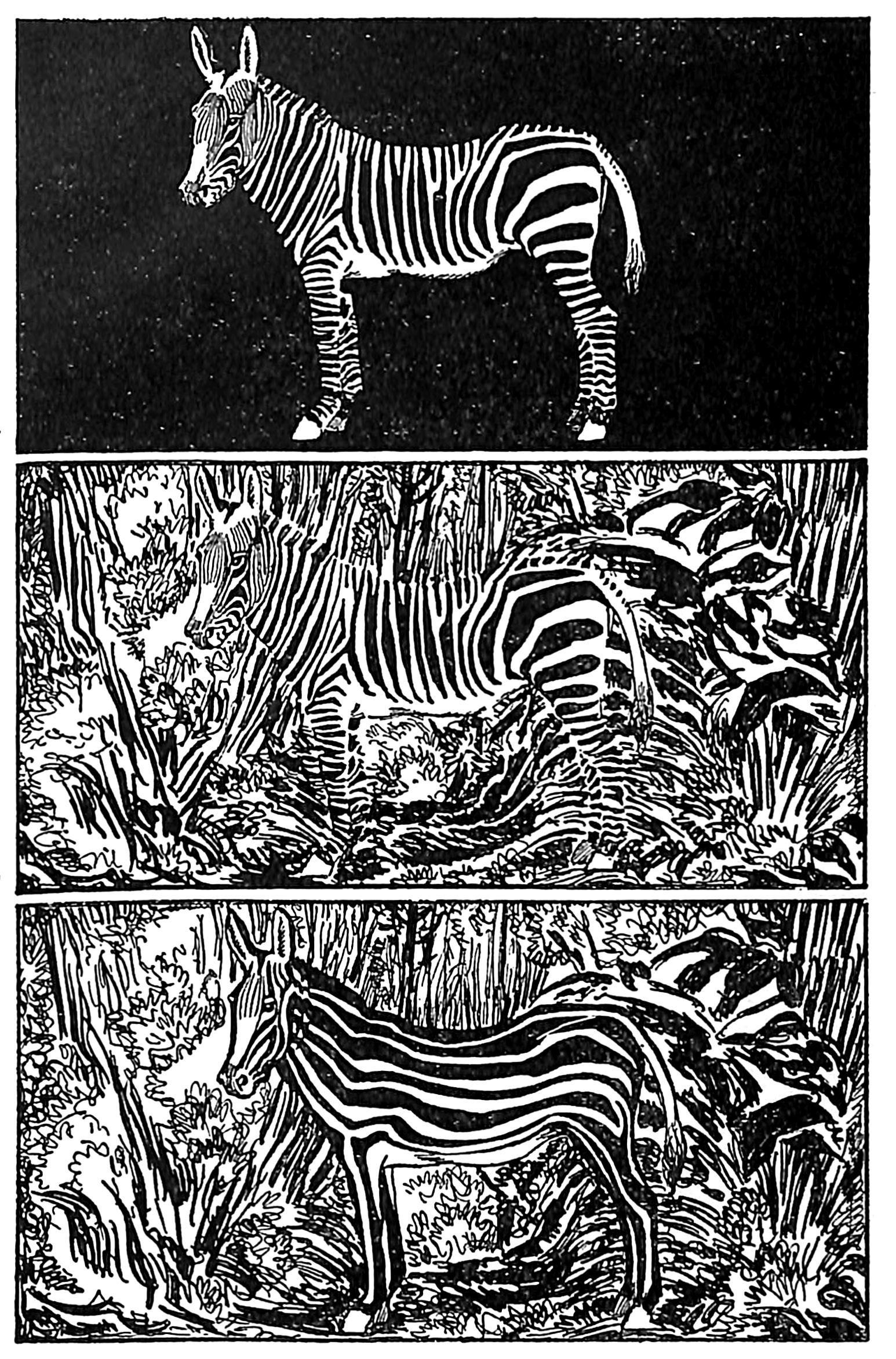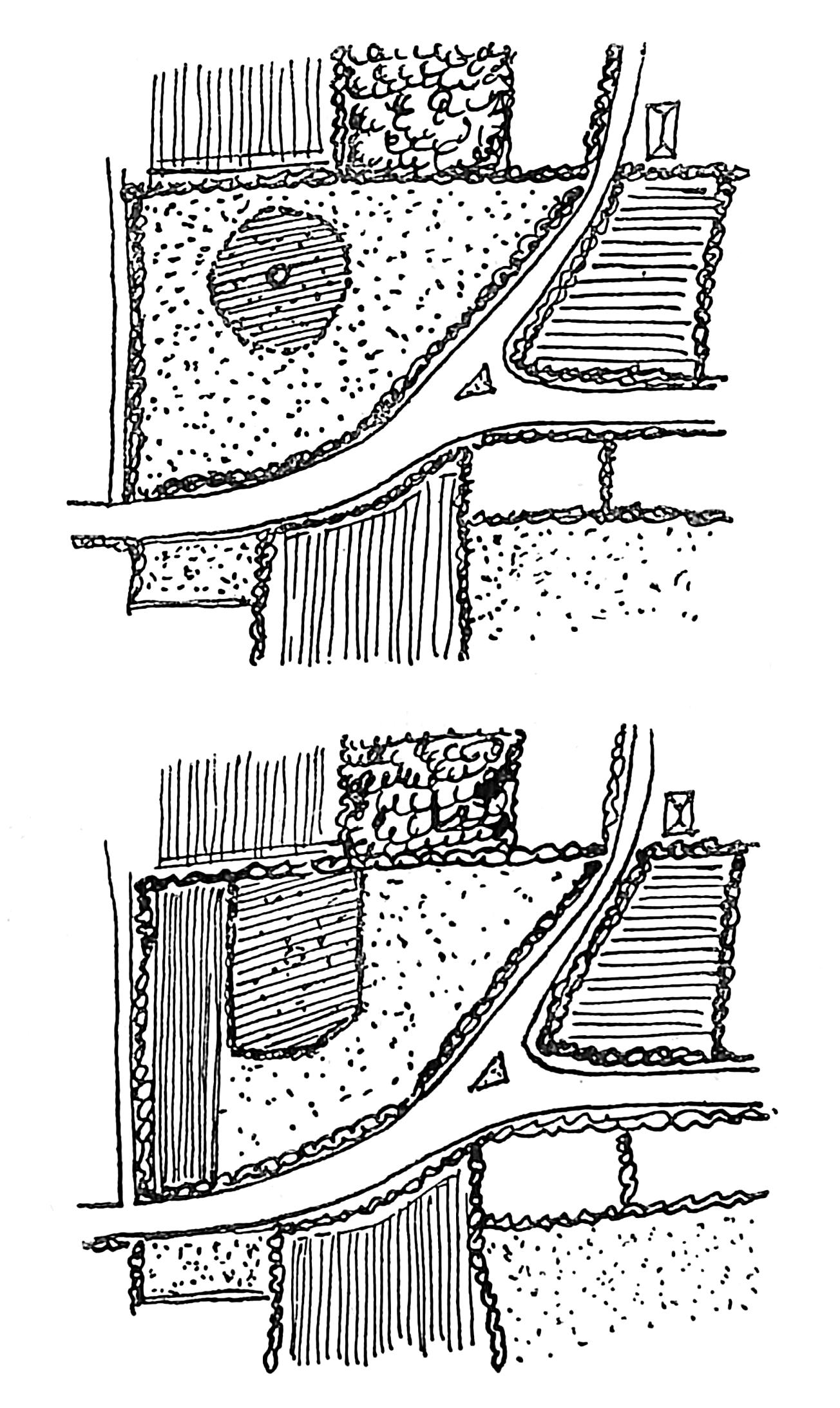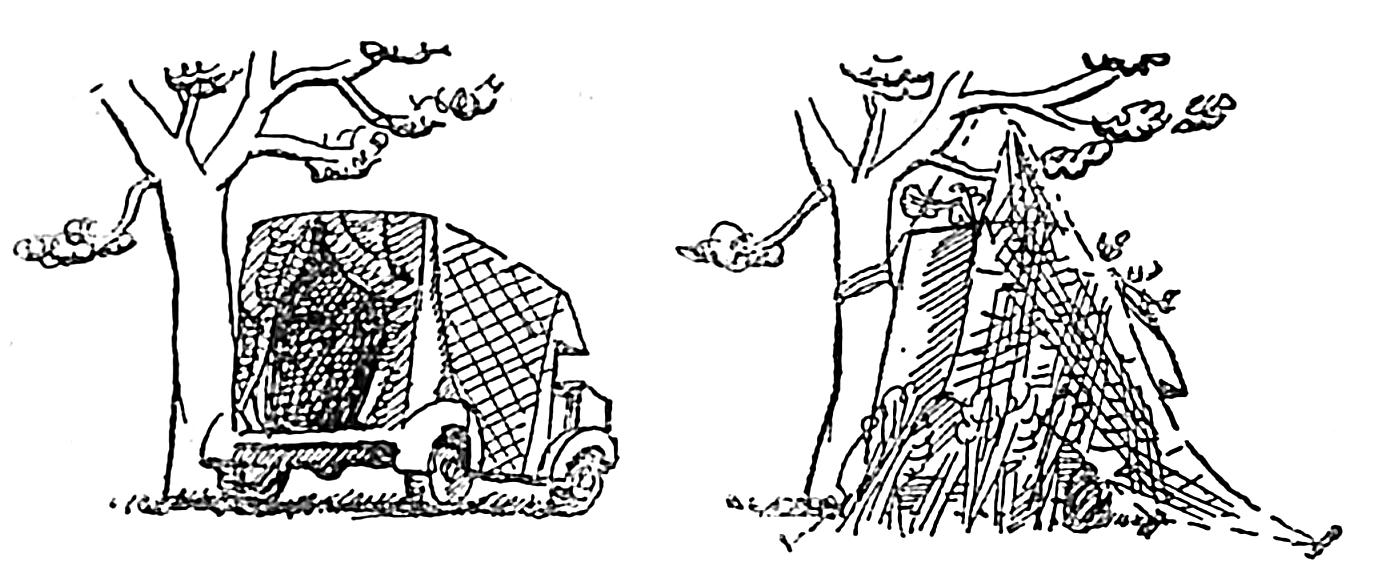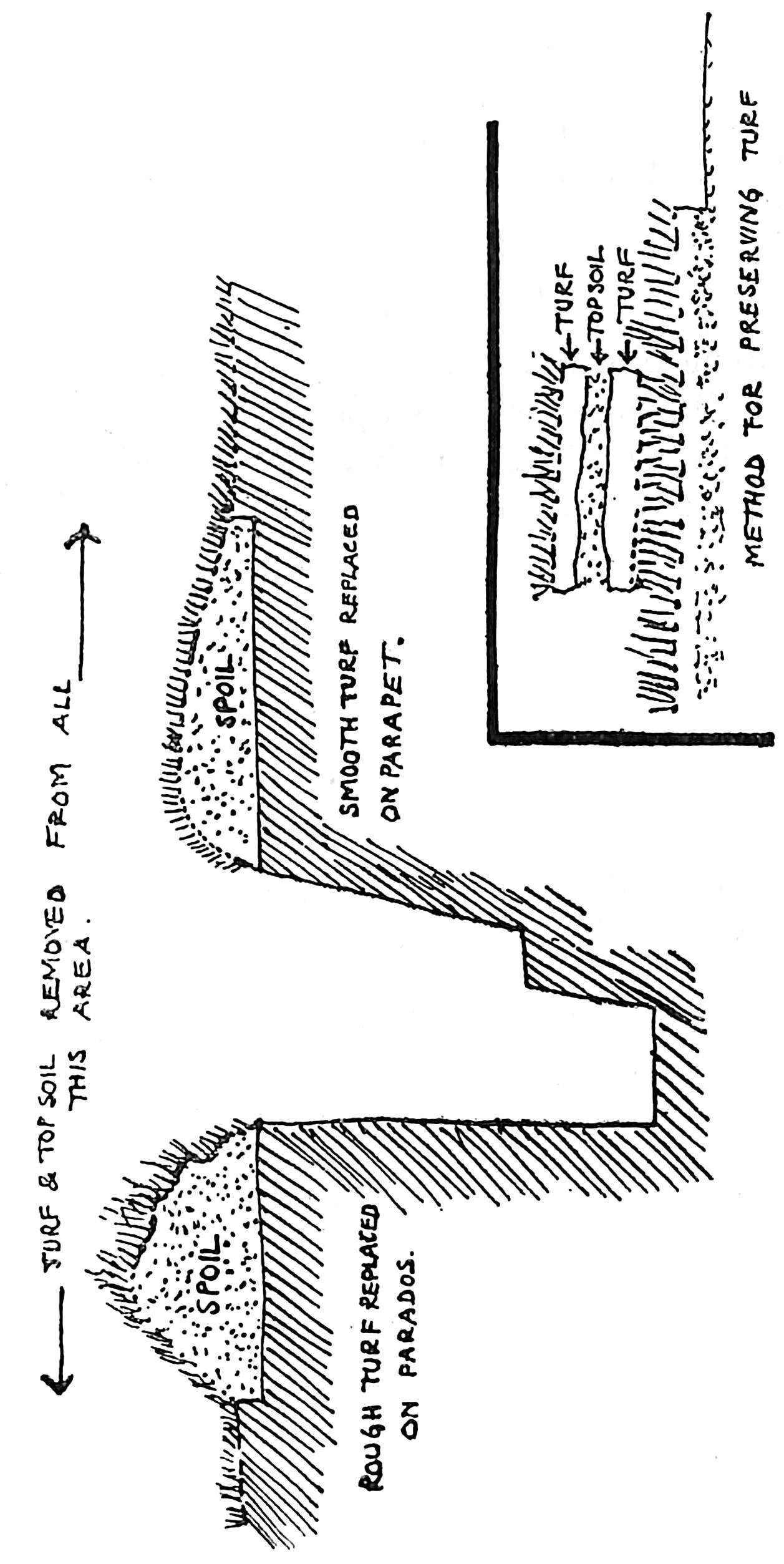
First published • October 1941
Second impression • October 1941
Third impression • December 1941
Fourth impression
• March 1942
Fifth impression • April 1942
Printed in Great Britain by Butler & Tanner Ltd., Frome and London
Sixth impression • March 2022
ISBN: 978-0-953238-97-2
This edition published by Lee Miller Archives Publishing Origination by Unicorn Publishing Group
Printed by Gutenberg Press, Malta
background—Resemblance in colour— Resemblance in texture—Obliterative shading— Disruptive patterns—Concealment of small vital points—Elimination of
page
VII. Fixed Positions—
in brick or concrete walls—Loopholes in sandbags—Loop-holes in mounded positions—Dummy loop-holes.

Fig. 2.
A. The zebra against the wrong background is very conspicuous.
B. Against its native background it is well hidden.
C. The disruptive pattern would not be effective if designed to outline the form.
while his belly is in shadow ; it will be possible to counteract the natural effect of light and shade by keeping its back dark and its belly light (see Fig. 3).
4. Disruptive patterns. The most striking ex-

Fig. 3.—Examples of Obliterative Shading.
A. Mackerel, wrong lighting. B. Lighting from above.
C and D. Gun-barrel uniformly painted makes heavy shadow underneath.
E and F. Gun-barrel painted dark on top and light underneath obliterates shadow.
ample of a disruptive pattern is to be found in the zebra. The strong contrast of black and white stripes with which it is covered would appear to make it highly conspicuous (see Fig. 2). Actually these markings, in its natural back-

Fig. 7.—Methods of parking Vehicles so as to conceal cast Shadows.
In dry weather it is sometimes possible to confuse the regular outline of a cast shadow by burning patches in the grass on all sides where the shadow may fall.
Behaviour
We have seen in nature that animals are able to obtain concealment by an instinctive sense of how to behave. It may be a question of getting rid of a tell-tale shadow or of taking up a position and remaining motionless, so as to imitate a branch or a leaf or it may be the acting of some farce, so as to draw the enemy’s attention away from a nest. In particular the most striking instance is the way in which they choose the correct background for their disguise and know how to take up attitudes which will fit in with it. These are lessons which every scout should take to heart. No concealment is possible for him without an understanding of how to use cover and how to avoid being silhouetted against the skyline, how to move and when not to move. The danger of standing up against the skyline is well known, but it is often forgotten that it may be just as serious to stand out in the sunlight, in front of the dark shadows of a wood or to stand in shadow and be silhouetted against a patch of light beyond. In fact it is when a man

12.—Siting of Wire round a Position. A. Bad. B. Good.
effective, that is, supposing he limits himself to frontal attack. His task will be all the more simplified if he decides on a simultaneous airborne attack in the rear ; since his knowledge of the strong points obtained from air observation will enable him to avoid opposition when landing his paratroops, while these strong points are kept well occupied by dive bombers.
If, however, this question of pattern is well understood, concealment will be the natural result. If the existing lines of the landscape, formed either by nature or the normal activities of man, can be followed in siting trenches, wire, anti-tank ditches and mines and in planning the parking of vehicles and tracks, then camouflage will not be an expensive and complicated form of magic which can only be achieved by trained experts, but the logical outcome of an understanding of how to fit into the background against which we are being observed. Good siting is 90% of concealment.
Tracks
A track is one of the symptoms of activity which is most likely to betray our positions to the enemy. It is possible to conceal a strong point perfectly and yet give away its exact position by a track leading up to it.
From ground observation the wheels and the shadow underneath the vehicle should be concealed. This can be done with sacks or brushwood. The shadow at the back of the

A. Wrong. A B B. Right.
Fig. 20.—Concealment of a Vehicle with M.T. net.
interior of a lorry should be hidden by keeping the curtains closed or covering the opening with a net. If nets are lacking, branches and scrub can be used on the roof (see Fig. 20).
DUMMIES AND DECOYS
In order to mislead the enemy the defending force can make good use of dummies of various kinds, especially when movement is rapid and the advancing force has had little time to reconnoitre. Dummy positions and guns or human dummies are the most obvious forms, but there are many others that can be imagined.
Dummy Positions
Dummy positions can in some cases be made from positions that have been put up as part of a former defensive scheme and since abandoned, preferably because of their conspicuousness. But such positions to be effective as dummies must still be given an appearance of being manned, otherwise they are not likely to interest the enemy. They may be camouflaged badly with clumsy, disruptive painting which will make them look all the more suspicious. The necessary signs of activity such as tracks and spoil should be kept alive. The positions must not be

be heavily garnished so as not to show up light against the shadow of the trench when seen from the air.
Bombing Pits
Bombing pits and cross trenches, being usually very small, may easily escape observation from the air, if all spoil is carefully removed and if they are sited under cover or in rough ground so as to become part of the pattern. They may be easily covered with a removable net or if they are in chalk soil, the bottom of the trench can be hidden with duckboards toned down with creosote.
Weapon Pits
An overhead cover made of wire netting, garnished with scrim or natural material, matching

Fig. 28.—The Spider. A. Open. B. Folded.
with the immediate surroundings, can be constructed, or a garnished M.T. net set up on a “spider” may be used. The M.T. net and methods of garnishing will be described below. The “spider” is a very simple device which

B. Right.
Fig. 29.—Weapon Pit covered with M.G. net and Spider. A. Wrong. B. Weapon dug in and spoil removed.
can be improvised (see Fig. 28). It is made from six-foot lengths of ¼-in. diameter steel wire, hinged round a central bolt ; when opened its six legs form a kind of umbrella which is strong enough to stand up without a central support. If the weapon pit is to be sited in the open it is
well to keep the net as low as possible so as not to attract attention from the ground and to avoid casting shadows (see Fig. 29).
Small Wire-netting Screens
Ground concealment for small weapons not dug in with crews of not more than two or three can be obtained by the use of a piece of rabbit

netting about 2 ft. 6 in. by 4 ft. and about 1½ in.
mesh set up with skewers pushed into the ground at each end. The netting should be painted and garnished with dyed hessian knots, steel wool or local rubbish. This net being easily portable and easily set up is suitable under highly mobile conditions, but care must be taken to see that the screen is in the light and that it is not silhouetted against the ground behind (see Fig. 30). Helmets should be well garnished.
colour or darkened with leaf juice, are interspersed along the barrel a disruptive effect is obtained. Sometimes a few small leaves can also be firmly attached in this way. The red band used to distinguish the American rifle can

also be hidden without being removed. Another method is to use a stocking or jacket of canvas which can be pulled over the barrel and attached with an elastic. If it is sufficiently well tailored it will lie flat on the barrel and not interfere
with the sights. It can then be painted disruptively. A third method which is more foolproof is to use a strip of hessian which can be also painted disruptively and stretched between the top sling swivel and the sling swivel on the butt. If it is given a jagged edge, it will be useful in covering the sling when the rifle is slung on the shoulder and it can be wrapped round the rifle when it is carried. When firing it will fall below the rifle and cannot hinder its action in any way, unfortunately it is liable to flap in the wind (see Fig. 35).
Boots and Gaiters
Boots and gaiters are more easily concealed when they are muddy. The polish required for parades should at once disappear when in action. Light brown leather gaiters are more conspicuous than dark brown or black. For sniping or scouting it is possible to cover boots and gaiters entirely by placing the feet in painted sacks, tied securely round the calves. This will not only hide them, but deaden the noise of hobnails on the road. An old pair of khaki socks may serve the same purpose.
Metal Badges
Metal badges should be removed or covered with khaki blanco or mud.

ground, but for the front of the suit which will be visible if a man is standing with his back to a tree trunk, a more vertical pattern which cuts diagonally across the body will be more in keeping. It is said that a trained Sapper should be able to make up a suit of this type in ten minutes. All he requires to do so is 11 ft. of hessian 6 ft. wide, scissors or a jack knife, strong thread, a packing needle and two shades of mat paint (see Fig. 37).
The Phantom Platoon
For sentries or snipers, the sniper suit disguise is certainly a help, but for a mobile patrol which may be moving across open country or among the streets of a town, similar disguises offer even great advantages. It should be possible, with training, to organise mobile patrols which will be able to move about their neighbourhoods and remain practically invisible. They will in consequence be of great value in operations as guides and observers. They will be able to form ambushes for the enemy and surprise and bewilder him without him being able to tell from where he is being attacked or observed. This can only be done by constant and imaginative training and by the skilful use of camouflage equipment. Camouflage does not usually need
